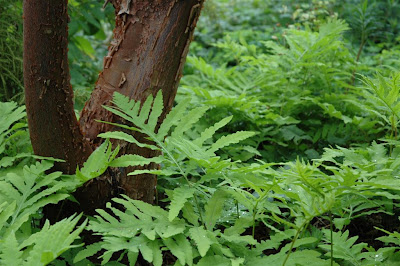One of the goals of Hermannshof is to experiment with plant groupings inspired by different natural habitats, and that includes woodland. The park is fortunate to have many mature trees to provide a believable woodland backdrop, including massive specimens of dawn redwood, larch and tulip tree. The open, sunny gardens gradually transition into woodland with some smaller woodland edge trees, such as magnolias and dogwoods, before being plunged into the deep shade of giants.



The woodland sections are just as richly planted as the prairie gardens, and the fascination with North American natives continues. Various types of epimediums, ferns, sedges, hellebores and hardy geranium form a dense and complex tapestry on the woodland floor. One of the most striking plants I saw, and which I didn't know before, was Paeonia mlokozewitschii. It was an eye catcher in a sea of green – prominent blue seeds in bright red pods, strong leaf shape and even some leaf colour at the beginning of August. And that's just the after-show, since it flowers in the spring.
One aspect of the woodland garden at Hermannshof which I found distinctive was the great number of grasses used, particularly in the edge areas. I noted Luzula sylvatica or Greater Wood Rush looking good (not pictured). There were also some showier perennials in the edge areas, such as Lillium martagon and Lobelia cardinales.


The pond deserves only a very short mention, as it was placed in a rather awkward spot on the side of the great central lawn. It was bordered by lawn on one side, and wetland plants on the others. Although I didn't find it anything special, it was interesting to note that it was still a magnet for visitors, as water always seems to be.


The last section I got around to was the perennial border on the woodland side of the great lawn. This is not accessible from the woodland garden, so you have to decide to walk all the way back across the central lawn see it. Part of this border used huge specimens of Hakonechloa macra to set up a strong rhythm, very dramatic even from far away. Further down, the plantings were more reminiscent of a classical mixed perennial border, but with some nice colour combinations which I think the pictures show off best.




Well, that's it for Hermannshof. The romp through Germany continues next time with a garden which was, unfortunately, a bit of a disappointment... didn't think that was possible in Germany, did you?



I really enjoyed your series on Hermannshof. It was not on my radar but definitely is now. The pictures were magnificent. I am looking forward to examining them more closely!! Thanks.
ReplyDeleteThanks Michael. It's certainly a very worthwhile garden should you ever find yourself in the neighborhood.
ReplyDeleteJ'ai beaucoup aimé vos reportages sur le Hermannshoff j'ai vraiment envie d'aller le voir l'an prochain.
ReplyDeleteMerci beaucoup Brigitte. J'espère que vous aurez la chance de visiter Hermannshof l'année prochaine. Et votre jardin est magnifique!
ReplyDelete